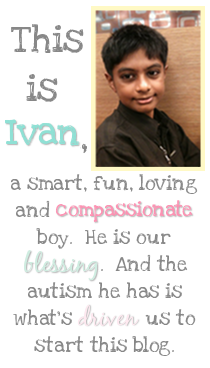It is difficult to narrow down the specifics of Apraxia. You may be unsure as to whether or not your child has it. I did a lot of observation on Ivan, in the early stages, to help me to help him. These observations helped me a lot when we went to professionals for help.
Some books tell us that childhood apraxia are often inherited from the family. But yet others say, that it could be a unique case for any particular child. Nothing is carved in stone, to each its own. Here are a few pointers based on the age of a child, that I think will be helpful to you.
Warning Signs in Infancy (Birth to Age 1)
- There is decreased cooing or babbling. Others comment on what a "quiet baby" you have.
- May have feeding difficulties.
- Your baby's first words appear late (after 14 months) or not at all.
- If first words do appear, they are often "easy," sounds (phonemes) replaced with even easier ones. For example, "hi" might sound like "I," but is used in a greeting context.
Warning Signs in Early Childhood (Age 1 to 3)
- Understands most of what is said, but cannot verbalize well. Large gap between receptive and expressive language.
- Cannot correctly use sounds.
- Difficulty imitating words and phrases
- Messy and distracting eating. Requires prompts to take a bite, chew, swallow, and drink; may overstuff or "pocket" food in the cheeks.
- Hyper-or hyposensitivty to oral activities such as eating different textures of foods or brushing teeth; difficulty identifying an object in the mouth through touch.
- Prosody (melody) of speech is affected. Also may only be able to repeat a word/sound/phrase in the context of a practical routine; may "lose" words, and may have inability to repeat words when asked.
- May have developed elaborate nonverbal or gestural communication.
- Struggles with speech; "searching" (groping) for the right word.
- Leaves sounds out of words (e.g., "cookie" becomes "coo-ie").
- The longer the phrase attempted, the less understandable the child becomes.
Warning Signs at Any Age
Neurological problems (problems that affect cognition, body mechanics, or the sensory system) may occur with a variety of childhood conditions. Those that may accompany CAS include:
- The child often gestures and grunts in lieu of oral communication.
- Gross motor skills (running, jumping, climbing) may also be slow in developing.
- The child appears clumsy or uncoordinated , has poor body awareness (proprioception), or difficulty with fine motor skills (holding a pencil, using scissors)
- IQ testing shows high performance IQ (doing tasks) and low verbal IQ (taking tasks).
- Poor sequencing (the child has difficulties putting a series of movements in order-e.g., figuring out how to get on an unfamiliar piece of playground equipment, or sequencing events to relate to others).
- The child has poor auditory processing (listening and reacting appropriately) and others must repeat themselves often.
- Greater difficulties in learning to read, spell, and write.
- Difficulty with a variety of components of speech (pitch, quality, rate, etc).
- Correctly saying "difficult" words is well...difficult (e.g., "butterfly," "rocking chair," "exercise").
- The child can make the sound(s) of many letters when the letter is alone, but when combined in a sentence, will not be able to say it.
- Limited (correct) use of vowels and consonants
- May have developed elaborate nonverbal and gestural communication.
- Family history of delayed language development, as well as family propensity to have other learning problems.
Book: Speaking of Apraxia by Leslie A. Lindsay, R.N., B.S.N.
I really hope that the information we share with you, are useful to you and your family.






















No comments:
Post a Comment